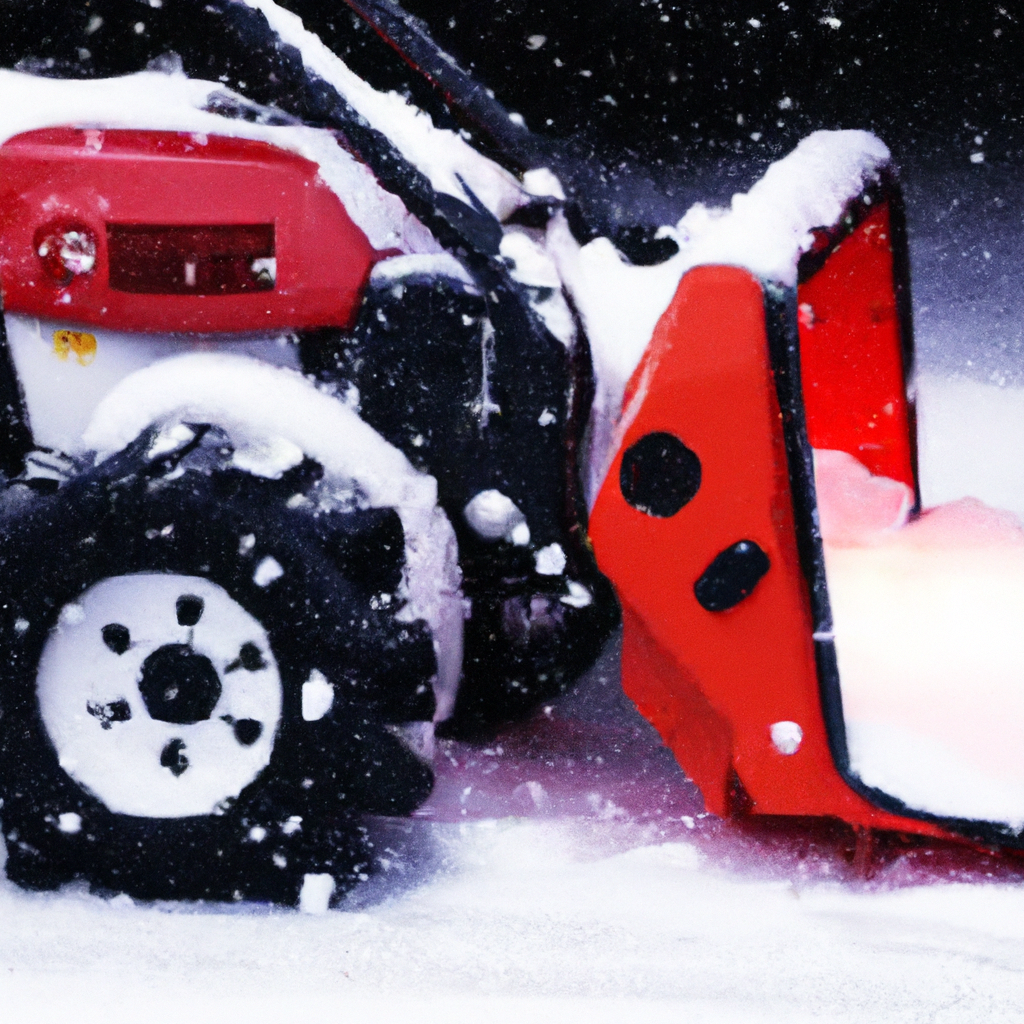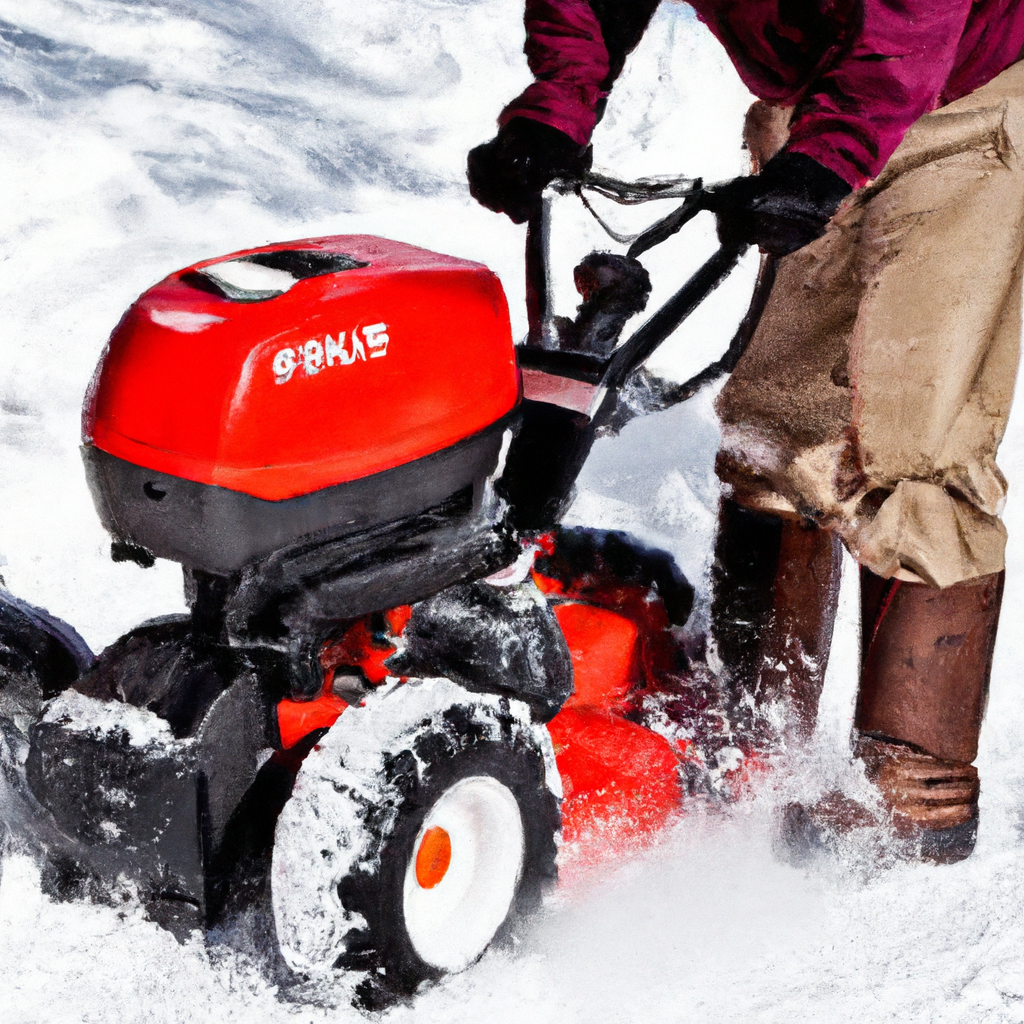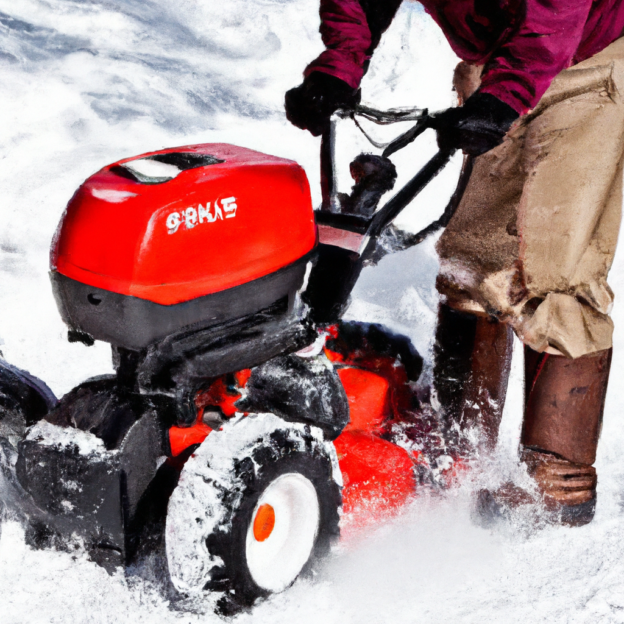Winter is here, and that means one thing: snow. And if you’re the proud owner of a snowblower, you’re in luck – clearing your driveway and walkway has never been easier. But before you rev up that powerful machine, it’s important to think about safety precautions. Snowblowers can be a convenient tool, but they can also be quite dangerous if not handled properly. In this article, we’ll discuss some essential safety tips to keep in mind when using a snowblower, ensuring that you can tackle that snowstorm with confidence and peace of mind. So, let’s get started!

Wear Appropriate Safety Gear
When using a snowblower, it is essential to wear the appropriate safety gear to protect yourself from potential hazards. This includes eye protection, ear protection, suitable clothing, and proper footwear.
Eye Protection
Snowblowers can throw up debris and snow, which can pose a risk to your eyes. To safeguard against this, always wear safety goggles or glasses that provide adequate eye protection. These will prevent any flying debris from entering your eyes and causing injuries.
Ear Protection
Snowblowers can generate significant noise levels that can be harmful to your hearing. To protect your ears, it is crucial to wear earplugs or earmuffs. These will help reduce the noise levels and prevent any potential hearing damage.
Clothing
When operating a snowblower, it is important to dress appropriately for the weather conditions. Wear warm, layered clothing to stay comfortable and protected from the cold. Additionally, avoid wearing loose articles of clothing and ensure that there are no dangling parts that could get caught in the snowblower’s moving parts.
Footwear
Choosing the right footwear is essential for maintaining your stability and preventing slips or falls while operating a snowblower. Opt for insulated, waterproof boots with good traction to provide grip and protect your feet from the cold and wet conditions. Avoid wearing shoes or sneakers that could become wet and increase the risk of accidents.
Read and Understand the Manual
Before operating a snowblower, take the time to thoroughly read and understand the user manual provided by the manufacturer. The manual contains vital information about the specific model, including safety instructions, operational guidelines, and maintenance procedures.
Familiarize Yourself with the Controls
One of the crucial aspects of using a snowblower safely is understanding how to operate its controls properly. Familiarize yourself with the different buttons, levers, and knobs mentioned in the manual. Ensure you know how to start and stop the machine, adjust the chute direction, and engage the various features.
Follow the Manufacturer’s Instructions
Manufacturers design snowblowers with specific instructions and guidelines in mind. Adhering to these recommendations is vital for your safety and the optimal performance of the snowblower. Follow the manufacturer’s instructions regarding fuel types, maintenance schedules, and any specific operational guidelines.
Understand the Maintenance Procedures
A well-maintained snowblower operates more efficiently, lasts longer, and poses fewer safety risks. The manual will outline the necessary maintenance procedures, such as cleaning, lubrication, and inspecting for wear and tear. Gain a good understanding of these procedures to ensure you can keep your snowblower in excellent working condition.
Clear the Work Area
Before you start using a snowblower, take the time to clear the work area to minimize hazards and maximize safety.
Remove Obstacles and Debris
Inspect the area where you’ll be using the snowblower and remove any obstacles such as rocks, branches, or toys that could get caught in the machine or become projectiles when blown by the snowblower’s discharge. Clearing the area ensures a smooth operation and reduces the risk of damage or accidents.
Ensure Proper Visibility
Good visibility is crucial for safe snowblower operation. Remove any snow, ice, or frost from your goggles or glasses to maintain clear vision. Additionally, ensure that the lights on the snowblower are clean and in working condition, especially if you plan to operate it in low-light or dark conditions.
Mark Hazardous Areas
If there are any hazardous areas or hidden obstacles in your work area, it is important to mark them to avoid accidents. Use visible markers, flags, or cones to clearly indicate locations such as tree stumps, uneven terrain, or hidden holes that could pose risks when operating the snowblower.
Keep Children and Pets Away
Never allow children or pets to be near or play in the area where you are using a snowblower. The noise, flying debris, and moving parts can be extremely dangerous, and it is crucial to keep them at a safe distance to prevent accidents or injuries. Make sure the work area is off-limits to children and pets until you have finished using the snowblower.

Do Not Overload the Machine
To ensure safe operation and avoid potential damage, it is important not to overload the snowblower.
Follow the Capacity Guidelines
Each snowblower model has its own capacity guidelines mentioned in the user manual. Overloading the machine by attempting to remove more snow than it can handle can lead to malfunctioning and potential hazards. Respect the manufacturer’s recommendations regarding the maximum snow depth and volume the snowblower can handle.
Avoid Wet or Heavy Snow
If you encounter wet or heavy snow, it is advisable to clear smaller amounts at a time rather than trying to move large, heavy piles. Wet or heavy snow can put excessive strain on the snowblower’s engine and moving parts, increasing the risk of malfunctions or accidents. Take your time and work in manageable sections to ensure safe and efficient operation.
Take Breaks to Prevent Overheating
When using a snowblower for an extended period, the machine’s engine may start to overheat. To prevent this, take regular breaks to allow the engine to cool down. Overheating can cause damage to the snowblower and pose a potential safety risk. Pay attention to the temperature gauge or other indicators provided by the manufacturer to monitor the engine’s temperature.
Beware of Moving Parts
Snowblowers have several moving parts that can be hazardous if not used correctly. It is important to be aware of these risks and take appropriate precautions.
Keep Hands and Feet Clear
Never attempt to clear clogs or remove debris from the snowblower’s auger or chute while it is running. Always ensure that the machine is turned off and all moving parts have come to a complete stop before attempting any maintenance or clearing. Keep your hands and feet clear of the auger and chute when the snowblower is in operation to avoid potential injuries.
Never Attempt to Clear Clogs with Your Hands
If the snowblower becomes clogged, never use your hands to clear it out. Instead, use a stick or another designated tool to dislodge any snow or debris. Using your hands can put them at risk of being caught in the machine’s auger, causing severe injuries. Keep a suitable tool nearby specifically for handling clogs or obstructions.
Use a Stick or Tool to Clear Debris
When using a tool to clear clogs or debris, ensure that it is sturdy enough and of an appropriate length. Avoid using flimsy or inadequate tools that may break or get stuck in the snowblower. Select a stick or tool that allows you to maintain a safe distance from the moving parts while effectively loosening or removing any obstructions.
Be Aware of Snow Discharge Direction
The snow discharge direction from a snowblower can pose potential risks if not managed properly. It is essential to be cautious and take necessary precautions.
Never Point the Discharge Chute Towards People or Buildings
Avoid directing the snow discharge chute towards people, animals, or buildings. The force and speed at which the snow is expelled can cause injuries or property damage. Always ensure that the discharge chute is aimed away from any potential targets and towards open areas or designated snow piles.
Set the Chute Direction Before Starting the Snowblower
Before starting the snowblower, ensure that the direction of the discharge chute is properly set and adjusted. Once the machine is running, it can be challenging to change the chute’s direction. Double-check the chute’s position and adjust it as needed to ensure that the snow is being discharged safely and away from any potential hazards.
Start and Shut Down Safely
Properly starting and shutting down the snowblower is essential for both your safety and the machine’s longevity.
Prepare the Snowblower for Startup
Before starting the snowblower, ensure that it is on a level surface and free from any debris or obstructions. Check the fuel and oil levels and follow the manufacturer’s instructions on priming the engine, choke settings, and any other startup procedures mentioned in the manual. Proper preparation will ensure a smooth and safe startup.
Start the Engine in a Well-Ventilated Area
When starting the snowblower’s engine, it is important to do so in a well-ventilated outdoor area. Carbon monoxide (CO) fumes can accumulate from the engine’s exhaust and be dangerous if inhaled in an enclosed space. Avoid starting the engine in a garage or any other confined area to prevent the risk of CO poisoning.
Shut Down the Snowblower Properly
When you have finished using the snowblower, shut it down according to the manufacturer’s instructions. Allow the engine to cool down before performing any maintenance or storing the machine. Properly shutting down the snowblower ensures safety and prevents potential accidents or damage.
Be Cautious on Slopes and Uneven Surfaces
Operating a snowblower on slopes or uneven surfaces requires extra caution to maintain stability and prevent accidents.
Maintain Good Balance
When working on slopes or uneven terrains, maintaining good balance is crucial. Keep your feet firmly planted on the ground and distribute your weight evenly. Avoid leaning or overreaching while operating the snowblower, as it can make it more difficult to maintain stability and control.
Engage the Traction Control
Most snowblowers come with a traction control feature to enhance maneuverability on different surfaces. Ensure that the traction control is engaged when operating on slopes or slippery surfaces. This feature helps provide better grip and stability, reducing the risk of sliding or losing control of the snowblower.
Avoid Steep Inclines
Avoid operating the snowblower on excessively steep inclines or surfaces that exceed the machine’s recommended capabilities. Steep slopes can increase the likelihood of tipping or losing control, which can lead to accidents or injuries. Use an alternative snow removal method for such areas or seek professional assistance if needed.
Keep Up with Maintenance
Regular maintenance is essential for keeping your snowblower in safe and optimal working condition.
Regularly Inspect and Service the Snowblower
Follow the manufacturer’s recommended maintenance schedule and inspect the snowblower regularly. Check for any loose or damaged parts and address them promptly. Keep the machine clean and ensure that all components are functioning correctly. Regular servicing will minimize the risk of breakdowns and ensure safe operation.
Check and Replace Worn Parts
Over time, certain parts of the snowblower may wear out or become damaged. It is important to periodically inspect and replace any worn or broken parts to maintain safe operation. Refer to the user manual for guidance on identifying and replacing these parts, or consult a professional if you are unsure.
Keep the Equipment Clean and Dry
After each use, it is crucial to clean the snowblower and remove any accumulated snow, salt, or debris. This helps prevent corrosion, damage, and potential malfunctions. Additionally, ensure that the snowblower is stored in a dry and secure location to avoid exposure to moisture or extreme temperatures, which can adversely affect its performance and safety.
Stay Alert and Be Prepared for Emergencies
When using a snowblower, it is important to remain vigilant and be prepared for any unexpected situations or emergencies.
Use Caution in Cold, Slippery Conditions
Operating a snowblower often involves being exposed to cold and slippery conditions. Exercise caution and take appropriate measures to stay warm and avoid slips or falls. Wear thermal clothing, proper footwear, and use secure footing techniques to minimize the risk of injuries caused by slips or falls on icy surfaces.
Have a First Aid Kit and Phone Available
Accidents can happen even when taking all necessary precautions. To be prepared for potential emergencies, have a well-stocked first aid kit available at your work area. Additionally, carry a fully charged phone with emergency contact numbers programmed in case immediate assistance is needed.
Know How to Stop the Snowblower in an Emergency
In case of an emergency, it is crucial to know how to stop the snowblower safely and quickly. Familiarize yourself with the emergency shut-off mechanism, such as the kill switch or ignition key. Practice using these mechanisms to ensure you can stop the machine promptly in case of an unexpected event.
By following these safety precautions and guidelines, you can ensure a safer and more efficient experience when using a snowblower. Prioritize your well-being and take the necessary steps to protect yourself, your property, and those around you. Stay informed, stay alert, and stay safe as you clear away the snow with your snowblower.
